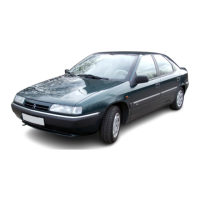97 Brakes The brakes
Citroen XM Internet Reference Version 1.0 145
3/3/99
97 Brakes
In my case, just a check and dust removal exercise. Watch the dust and spray with a dust subduing
substance and wear a face mask to be really careful. Remember, release the parking brake cables by
pushing on the operating lever and pulling off the cable end. Push the cable back out and under the car
a little way, otherwise you will crack the outer casing of the cable. Pull out the pin retaining clip and drive
out with a pin punch, the pin which keeps the calliper housing in place. You can then swing the calliper
upwards, whereupon the pads usually fall out. If changing the pads, remember that the pistons must be
rotated as they are pushed back into the housing to allow enough clearance for the new pads. I use an
old hub puller of the bar type (left over from motor-cycle days) in reverse to push the pads back and a 3/
4 " chisel to do the turning bit. You can buy a proper tool for this, or make one without too much difficulty.
Ensure that the little pin on the pads slots between a slot in the piston face, or you will be in trouble here.
It's very obvious what to do if you take your time over it. I would allow half an hour a side once the car is
on jacks and the wheels are off. Use copper grease on the pins. In my case, this time the pads were OK,
although the fronts will need renewal in the next 5,000 miles. Remember that as pads wear down, they
are less effective in dissipating heat and may pass on more heat to the discs. My discs will need
replacing (on the front) before 100,000 miles. Replace the pads in good time!
Brake Pads
There is one item I MUST correct! In an earlier article in 1994, I explained how, working 'blind' without a
manual, I changed the front brake pads. To do this, I removed the massive pivot pin which fixes the
calmer housing to the brake support assembly. Philip Wells tells me this is NOT a good thing to do,
because the pivot is given a coating of anti-shake fluid which 'bursts' as the pin is screwed into position,
thus sealing the threads and locking the pin in position. I thought it was hard to get out! The correct way
is to drive out the calliper locking pin on the lower front of the callipers (similar in fact to most front end
set-ups these days on other cars), unhinge the parking brake cable and then swing the callipers
upwards to give access to the pads.
The parking brake must be released for this operation.
If you need to buy the tool which screws the pistons round and at the same time presses them back into
the housing, let me know. Philip Wells can get them for about £6 each and would not mind us having the
address of the supplier. This would be cheaper than the Citroen tool, in all probability, and it fits on the
end of a square drive shaft out of the socket set you all must surely have to hand.

